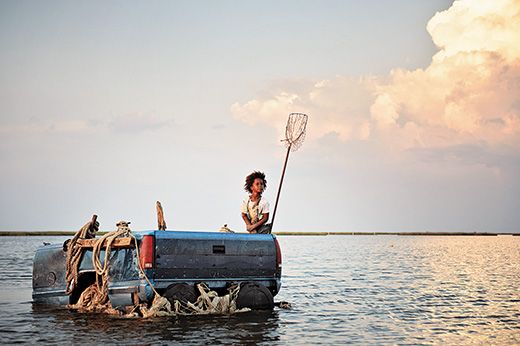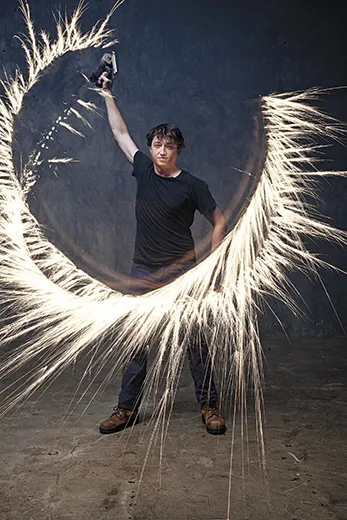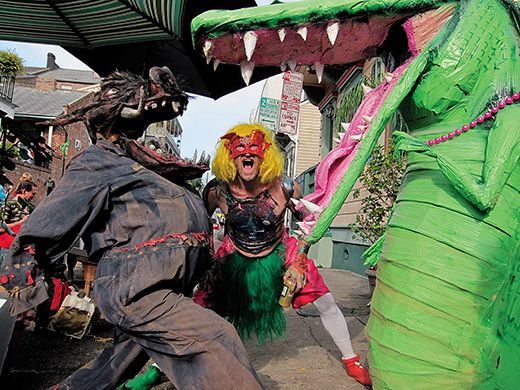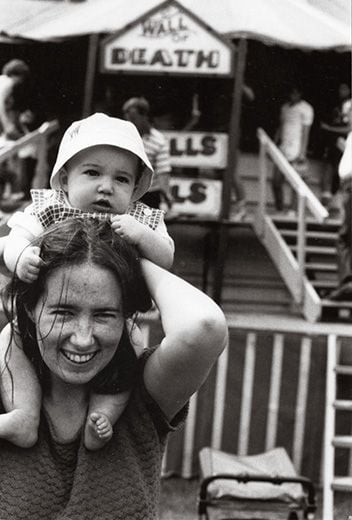How Benh Zeitlin Made Beasts of the Southern Wild
The Oscar nominee for Best Director transformed filmmaking as he assembled a new myth out of Hurricane Katrina
/https://tf-cmsv2-smithsonianmag-media.s3.amazonaws.com/filer/Ingenuity-Awards-Benh-Zeitlin-631.jpg)
Ed. Note (January 10, 2013): Congratulations to Benh Zeitlin and the cast and crew of Beasts of the Southern Wild for their four Oscar nominations, including Best Picture and Best Director for Zeitlin.
Sprawling on the edge of a levee along a deadened twist of the Lower Mississippi is a compound that, from 1894 to 1999, was the only leprosy hospital on the U.S. mainland. It’s late summer and, at my suggestion, Benh Zeitlin is exploring the facility that once housed hundreds of patients, many of whom were disfigured, feared and shunned.
Clouds mass in the Louisiana sky as the 30-year-old filmmaker roams the long masonry arcades with Mr. Pete, a leprosy survivor who’s lived on the grounds since 1951. Mr. Pete describes the stigma of the disease—his own hands are clawed—and the bitter pain of ostracism and isolation. “Lots of the afflicted were brought here against their will,” he says of the leprosarium, which for its first six decades was as much penal colony as sanctuary. Snatched from their homes, some sufferers arrived in hearses; others, sealed boxcars. Some came in handcuffs, even leg irons. “If you ran away, you had to stay away,” says Mr. Pete. “Get captured and you were locked up in a cell at the hospital jail for 30 days.”
Zeitlin listens to him with compassion and sympathy. The eldest child of folklorists who once worked for the Smithsonian Institution, he’s open, reflective and more than occasionally ironic. “That place sounded like a hellish version of a refugee camp,” Zeitlin later says. He’s nicely tousled, with a smooth, unlined face and clear eyes. “Outcasts were kept penned from the rest of society by well-intentioned people with a mandate to be humane. Essentially, an extreme example of what happens at the evacuation center in Beasts of the Southern Wild.”
Beasts is Zeitlin’s feature film debut, a small miracle of deliberate outsider art that entranced and exhilarated audiences during its limited theatrical run this past summer. Unruly, unbound by studios or the usual Hollywood conventions, this paean to childhood perception and human resilience exists in its own hermetically sealed world, physically and metaphorically. Zeitlin made the movie on a $1.8 million shoestring in southern Louisiana with hand-held 16-millimeter cameras, jury-rigged sets, untrained actors and a grass-roots collective of artists from around the country. By ignoring received wisdom and gambling on his own powers of invention, he offered further proof that innovation is about breaking rules.
Pitched between realism and folktale, the plot of Beasts involves the inhabitants of a damp, squalid bayou enclave—the Bathtub—beyond the levees that keep the delta dry. It’s a mixed-race utopia uncorrupted by politics, religion or consumerism. “The Bathtub is a harsh place to live,” Zeitlin says. “The residents give up the comforts of modern civilization, and what they gain is a freedom and unity that would be impossible on the other side of the wall.”
The locals are under siege from a hurricane and a government determined to pry them from their homesteads and relocate them to an emergency shelter. In their struggle against modernity, these proud fringe-dwellers are, to quote a rave review in the New Orleans Times-Picayune, “willing to fight all day for their right to eat and drink, sing and stumble all night.”
The film has earned the adoration of critics, who tend to sprinkle on superlatives like an Italian waiter working a pepper mill. “Hauntingly beautiful both visually and in the tenderness it shows toward the characters,” wrote Manohla Dargis of the New York Times in January after a screening at Sundance, where Beasts won the Grand Jury Prize as well as the cinematography award. At Cannes a few months later, it snagged the prestigious Caméra d’Or, which recognizes the finest feature by a rookie director. Beasts, marveled Richard Corliss in Time magazine, “speaks in words and images of a clarity and vision nearly unique in today’s independent cinema.”
Zeitlin’s vision is something of a cross between The Tempest and The Odyssey—as if told by Vardaman Bundren, the child in William Faulkner’s As I Lay Dying who thinks his dead mother is a fish. In this case, the child is named Hushpuppy, played with feral eloquence by 6-year-old Quvenzhané Wallis. When not warming up cat food for dinner—lighting the stove with a blowtorch!—the dandelion-haired heroine ministers to her pig, chickens and rough-but-loving father, Wink (Dwight Henry—a New Orleans baker by trade), who’s grievously ill.
Alone in her tumbledown trailer, Hushpuppy ponders the nature of time and her place in the cosmos. “The whole universe depends on everything fittin’ together just right,” she says. Her fervent imagination fills the screen with magic, from the motes glowing in the air to visions of aurochs, fearsome prehistoric behemoths that will reclaim the earth as ice caps melt. She’s convinced that animals and her absent mother—who she’s told “swam away” years earlier—talk to her, sometimes in code.
Zeitlin auditioned several thousand Gulf Coast girls for the role of Hushpuppy, initially conceived as age 9 to 12. “Of the 20 callbacks, half were white,” he recalls. Wallis, who’s black, showed up “looking like a warrior. She wasn’t exactly how we had imagined the character, but her spirit was the spirit of the movie.”
Though Wallis had never acted before, she handled direction and her director like an old pro. After one take, Zeitlin sidled up to her and said, “That was good. I just need a little more subtlety.” Wallis put him in his place. “I said, ‘I’m 6 years old!’” she recalls. “‘Do you really think I know what subtlety means? Come on! Gimme a kid word!’”
By reimagining the project to accommodate a kindergartner, Zeitlin completed a kind of counterintuitive directing trifecta. “There’s an old filmmaking adage: Avoid water, children and animals—they’ll destroy your film,” he says. Perhaps not coincidentally, all three elements are integral to Beasts. “The culture of filmmaking is antagonistic toward chaos. Most movies are designed to maximize order and structure. But if you come into a production with a preordained vision of how everything is going to be, you risk squeezing out spontaneity and ending up with this sanitized thing. I see my role as guiding the ship without controlling it too tightly, discovering the film by making it.”
Actually, Zeitlin didn’t so much make Beasts as mine it, generating material with his cast, then working with each actor individually. He strove for authenticity, paring the emerging possibilities until emotional resonance found its way onto the screen. “The narrative changed and adapted to whatever was going on,” he says. “We tested it against the actual people and places that are in it. If the story wasn’t true, it would break under the weight of those circumstances.”
That story was adapted for Beasts from Juicy and Delicious, a one-act play by Zeitlin’s pal Lucy Alibar. They had met around age 14 when both won a playwriting contest. “I wrote Juicy and Delicious after my funny, vibrant, strong-as-an-ox dad got sick and I was trying to make sense of the world,” says Alibar, who grew up in the Florida panhandle. “The character of Hushpuppy was a boy because the whole thing was easier for me to talk about in detail if it was all happening to someone else. The aurochs came out of the red Georgia clay, grits fell from the sky, and Hushpuppy came into a grace and understanding that I was struggling to reach.”
In writing and rewriting the screenplay, she and Zeitlin jettisoned standard plot and character motivation, allowing the fable to meander from adventure to adventure. “I like taking grand stories and building them by hand, making them out of small parts,” he says. That artisanal approach informs nearly every aspect of Beasts: the ingenuity his kid sister Eliza showed in patching together entire sets out of scrap metal she found on location; the care with which cinematographer Ben Richardson shot the film from Hushpuppy’s four-foot-high perspective and turned detritus into objects of ragged beauty.
Zeitlin’s attention to detail is perhaps most evident in the swirling, Cajun folk-inflected score, which he co-wrote with composer Dan Romer. During marathon sessions in a Brooklyn recording studio, Zeitlin—who polished his musical chops in the high-school grunge band Sorry Porky—and Romer would toss lateral riffs back and forth like footballs. “We’d ad-lib for 20 hours straight,” says Romer. “I feel like Benh intentionally left out certain parts of the movie just so the music could fill it in.”
Such was the improvisational spirit that guided Zeitlin’s vision into cinematic reality. “Every member of the crew was encouraged to contribute ideas and content,” he says. “Whether it was sets, location or actors’ work, the idea was to let the people creating what will end up on-screen be themselves.” To create the marauding aurochs, a herd of Vietnamese potbellied pigs were outfitted with nutria skin and latex horns, then filmed from low angles in slow motion. “We made the movie as if it were a collage or a junk sculpture,” says Zeitlin. “We invited chaos into the process.”
He’s been cozy with chaos since boyhood. He was born and raised in New York City, where his favorite spot was the pinnacle of the Cyclone, the historic wooden roller coaster in Coney Island. He still makes a point of taking the white-knuckle ride every time he visits the city. “There’s a kind of euphoria that comes with knowing you’re about to do something terrifying and beyond your control,” says Zeitlin. “I get the same sort of thrill while making a movie.”
He and Eliza misspent much of their youth in Coney Island. Their parents, folk arts scholars Steven Zeitlin and Amanda Dargan, would bring them along while collecting oral histories at the amusement park. “Our family spent lots of time with carnival barkers and other sideshow performers,” says Dargan, who, like her husband, earned a PhD at the University of Pennsylvania. “The four of us share a real love and appreciation for iconoclasts who hold on to older forms of entertainment and keep going as long as they can. They’re extraordinarily wonderful people.”
Young Benh befriended a contortionist called the Elastic Man; Screwy Louie, the “Human Blockhead” with a talent for hammering nails up his nose; and Otis Jordan, formerly Otis the Frog Boy, whose act was to roll and light cigarettes using only his lips and tongue. “To me, unique perspectives and self-sufficient lifestyles are sacred things that should be fought for and preserved,” he says. “So-called ‘eccentrics’ were my earliest heroes, and one of my biggest influences.”
Biggest of all were his father and mother, who oversee City Lore, a non-profit cultural-heritage center in Manhattan. Longtime advocates for the dispossessed, they taught him to look for beauty in the tales and characters at the interstices of contemporary life. “My parents believe art isn’t just confined to museums and textbooks, but lives in everyday communication,” he says. “They found poetry in the jokes told around the dinner table, the pitches that street vendors make to sell T-shirts, in murder ballads from the Old West.”
As a staff folklorist for the Smithsonian, Steven had once recreated an old-time traveling medicine show for a film shoot in Bailey, North Carolina. Later, young Benh and his sister staged puppet shows and made home movies. “I was always interested in epic tales and characters,” he says. In his first film project—made with a friend at age 5—he played Superman. His entire family pitched in on the production.
Twice a year the clan made pilgrimages to Dargan’s rural South Carolina homestead for a get-together known as the Winter Games or Summer Games. “We always felt it was important to maintain a sense of ritual and touch base with the past,” she says. Scores of relatives would gather for a day of sack races, skeet shooting and storytelling picnics. The chicken chase later became the subject of Benh’s college entrance essay, while the pig roasts would anticipate the exuberant crayfish boils in Beasts.
Eventually, on the advice of a summer camp counselor, Zeitlin enrolled in the film program at Wesleyan University in Connecticut. He and a bunch of like-minded classmates formed Court 13, a collective named after the abandoned squash court it commandeered. Members of the court included Beasts producers Dan Janvey and Michael Gottwald, and Ray Tintori, the film’s special effects wizard. “Court 13 is more of an idea than an organization,” says Gottwald. “We’re dedicated to making films as a community about communities on the edge of the world. Limitations are motivating forces for us. We love to bust through challenges.”
It was on the Court 13 soundstage that Zeitlin mounted the stop-motion animation for Egg, his senior thesis project for cinema studies. A hallucinatory retelling of Moby Dick—with a yellow yolk standing in for the white whale—Egg won the Grand Jury Sparky Award for Best Animation Short at the 2005 Slamdance Film Festival, a Utah rival to Sundance.
After graduation, Zeitlin spent time in the Czech Republic and apprenticed under animators working with Jan Svankmajer, a surrealist renowned for using familiar, unremarkable objects for deeply disquieting ends. During the summer of 2005, Zeitlin more or less lived on a park bench in Prague, trying and failing to find the right place to shoot a short film about two lovers—one above the water and one below. He hoped to shoot this soggy saga on a Greek island.
But while following the devastating path of Hurricane Katrina on his cellphone, Zeitlin had a Eureka moment: He would tie the story to the storm. So he and his Court 13 cohorts made their way to New Orleans to make Glory at Sea, a heartfelt fantasy about a group of mourners who build a raft out of debris and rescue their loved ones trapped beneath the waves.
What was supposed to be a five-minute film with a month-long shoot and a budget of $5,000 snowballed into a 25-minute epic that spanned a year and a half and cost $100,000, including $40,000 that Zeitlin amassed in credit card debt. Glory premiered at the 2008 South by Southwest Festival in Austin, but Zeitlin never got to the screening. The car in which he was a passenger was rear-ended by a drunk driver, shattering his hip and pelvis. During Zeitlin’s six-month convalescence, an insurance settlement and the proceeds from a benefit show held by fellow indie filmmakers allowed him to clear his debt.
While making Glory, Zeitlin took field trips to the marshes at the bottom of the delta. On one expedition he stumbled on Isle de Jean Charles, a fishing village he calls “the last chunk of land before you fall into the water, a tenacious community that refuses to be pushed inland.” To Zeitlin, Isle de Jean Charles seemed to have been airlifted out of Werner Herzog’s La Soufrière, a 1977 documentary about the end of the world. In that film, set on an abandoned Caribbean island, a native man chooses to stay put in the face of a looming volcanic eruption.
After his visit, Zeitlin resolved to spin a yarn about holdouts. “I wanted to celebrate people living on the precipice of destruction, hanging onto and fighting for their homes,” he says. He also wanted to examine how it felt to lose a way of life, a culture or, for that matter, a parent, and “how you respond emotionally to survive that.’’
The huge emotional response to Beasts has not gone unnoticed by movie studios, whose overtures to Zeitlin and his collective have so far been held at bay. “They want us,” he says, “but they’re not getting through.” Though Zeitlin is reluctant to discuss his next project, he will say that the story unfolds in “a place where aging operates like a variable, where people can age rapidly or very slowly.”
An immodestly budgeted blockbuster this won’t be. Zeitlin fears that by going Hollywood, he would almost surely have to sacrifice his treasured authenticity. “At Court 13, we’re attempting to create art within our own system by our own special code,” he says. “We want to keep the family intact, generate original material and tell our own stories.”
He quotes the fashion photographer Bill Cunningham: “If you don’t take their money, they can’t tell you what to do.”



